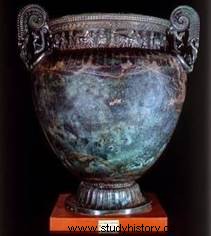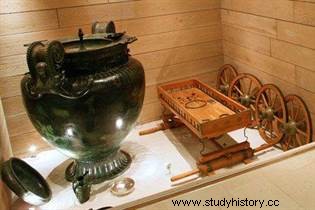 The Tomb of Vix was discovered in 1953 in Burgundy, at the foot of Mont Lassois, place of one of the great princely residences of the civilization (or culture) of Hallstatt. The Treasure of Vix's Tomb belonged to a Celtic princess who lived in the oppidum of Mont Lassois in the 5th century BC, a region that prospered thanks to the passage of tin from Cornwall to the Mediterranean. The centerpiece of this tableware is a 1.64 m high bronze volute krater, the largest that Antiquity has bequeathed to us. This discovery confirms that trade currents linked the heart of Gaul and the Mediterranean world several centuries before the Roman conquest.
The Tomb of Vix was discovered in 1953 in Burgundy, at the foot of Mont Lassois, place of one of the great princely residences of the civilization (or culture) of Hallstatt. The Treasure of Vix's Tomb belonged to a Celtic princess who lived in the oppidum of Mont Lassois in the 5th century BC, a region that prospered thanks to the passage of tin from Cornwall to the Mediterranean. The centerpiece of this tableware is a 1.64 m high bronze volute krater, the largest that Antiquity has bequeathed to us. This discovery confirms that trade currents linked the heart of Gaul and the Mediterranean world several centuries before the Roman conquest.
The tomb of the “lady” of Vix
It was at the beginning of 1953 that a sumptuous tomb was discovered on Mount Lassois, which was soon named Trésor de Vix. The oppidum of Mont Lassois (Côte-d'Or) is located about fifty kilometers from the sources of the Seine, near Châtillon-sur-Seine. In the eastern part of this site, the local archaeological society led by Maurice Moisson unearthed the tomb of a young woman, buried at the beginning of the 5th century BC.
Located in the heart of a vast funerary complex made up of a dozen necropolises within a radius of about twenty kilometers, the tomb of Vix is about 3 meters wide next to. richer than the neighboring burials, it shows the care the Celts took to honor their most important dead. The person found in the tomb is a woman and is assumed to be a princess. She played an eminent role there, which earned her the benefit of the Celtic ritual, which until then had been reserved for men.
She was buried around 480 BC. AD in a tomb under a tumulus, lying on the body of a chariot whose four wheels and drawbar had been dismantled and placed against a wall. The deceased had been sumptuously adorned:bronze rings on the ankles, bracelets and necklace of amber and hard pearls, bronze necklace, fibulae, and above all an admirable golden diadem which still clung to the skull. She took to the afterlife three Etruscan bronze basins and the utensils necessary for the banquet. Above all, it was a magnificent bronze crater, of exceptional size and exceptional quality, which immediately contributed to Vix's fame.
The contents and layout of Vix's Tomb
 Thousands of ceramic shards, iron objects, bronze tableware, brooches, jewelry (schist bracelets and amber beads), a huge crater and a funeral chariot were therefore found in the tomb. Most of these objects are of local origin, but some come from Greece or Italy. This proves the intensity of commercial exchanges between the Hallstattian domain and the Mediterranean world.
Thousands of ceramic shards, iron objects, bronze tableware, brooches, jewelry (schist bracelets and amber beads), a huge crater and a funeral chariot were therefore found in the tomb. Most of these objects are of local origin, but some come from Greece or Italy. This proves the intensity of commercial exchanges between the Hallstattian domain and the Mediterranean world.
The layout of the tomb is as follows. The chariot on which the body is placed runs along the wall, while the crater and the bronze dishes line the western wall. A drinking service is placed on the lid of the crater. The head is directed towards the north. The deceased is adorned with brooches, various jewels and a gold torque. It is assumed that this arrangement is not due to chance and that it responds to a staging that underlines the particular meaning of each object.
Thus, the dishes and the crater, intended to contain a large quantity of alcoholic beverage, testify to my presidential function of the Lady of Vix during banquets. The chariot, meanwhile, is adorned with bronze plaques whose motifs refer to the myth of Apollo and the cyclic journey of the sun on his chariot or his boat. Of all the pieces found, it is above all the krater of Vix, an immense Greek vase, and the torque that arouse the admiration of all.
The crater
 This krater is considered the largest bronze vase of antiquity. So much so that scientists are questioning the know-how of the craftsmen of the time because it seems impossible to achieve it again. Indeed, it measures 1.64 m in height and 1.27 m in diameter, weighs 208.6 kg and can contain 1,100 liters. Its use is not fully defined. If this style of vase is used to mix water with thick wine, here it seems that its function is more prestigious than utilitarian.
This krater is considered the largest bronze vase of antiquity. So much so that scientists are questioning the know-how of the craftsmen of the time because it seems impossible to achieve it again. Indeed, it measures 1.64 m in height and 1.27 m in diameter, weighs 208.6 kg and can contain 1,100 liters. Its use is not fully defined. If this style of vase is used to mix water with thick wine, here it seems that its function is more prestigious than utilitarian.
It has, in fact, been shown that the collective consumption of alcoholic beverages reinforces the prestige of the chef in Celtic society. The decoration of the vase, made by Greeks in southern Italy around 520 BC. AD is of high quality. Note the handles in volutes supported by gorgons whose bodies end with the tail of the serpents, as well as the collar decorated with a band in relief representing a parade of hoplites and quadriga.
The torque
The gold torc is also a unique piece among the ornaments of this period. Hesitations remain as to the nature of the jewel because it was found on the skull of the princess. It could be a tiara, but some archaeologists attribute this position to a collapse which changed the location of the objects in the burial, and consider it to be a torque adorning the neck of the deceased. It weighs 480g and matches the shape of the omega. Its pear-shaped ends are turned outwards. They are joined to the whole by lion paw motifs, themselves decorated with winged horses, finely worked Pegasus.
 The literature concerning the origin of this jewel is dense. It could be Etruscan or local. But, even in the latter case, one cannot neglect the Mediterranean influences which it is imbued with.
The literature concerning the origin of this jewel is dense. It could be Etruscan or local. But, even in the latter case, one cannot neglect the Mediterranean influences which it is imbued with.
A rare testimony to the Celtic world in Gaul
This rich funerary furniture leaves no doubt about the princely origin of the deceased, especially since other tombs of this type, notably that of Hochdorf, have been discovered. A burial of this size suggests that women played an important role at the time.
The items could be restored, and the tank was rebuilt. Like that of other princely tombs, this furniture testifies to the wealth of the Celts of the ancient period and their interest in Mediterranean civilizations.
The treasure of Vix is now on display at the Musée du Pays Châtillonnais, in Châtillons-sur-Seine in the Côte d'Or. The site of the discovery is still the subject of archaeological excavations carried out by INRAP.
To go further
- The tomb of Vix:A treasure between history and legend, by Félicie Fougère and Bruno Chaume. Fage Editions, 2016.
- Celtic princes and princesses. The Early Iron Age in Europe, 850-450 BC. AD, by Patrice Brun. Wandering, 1987.
